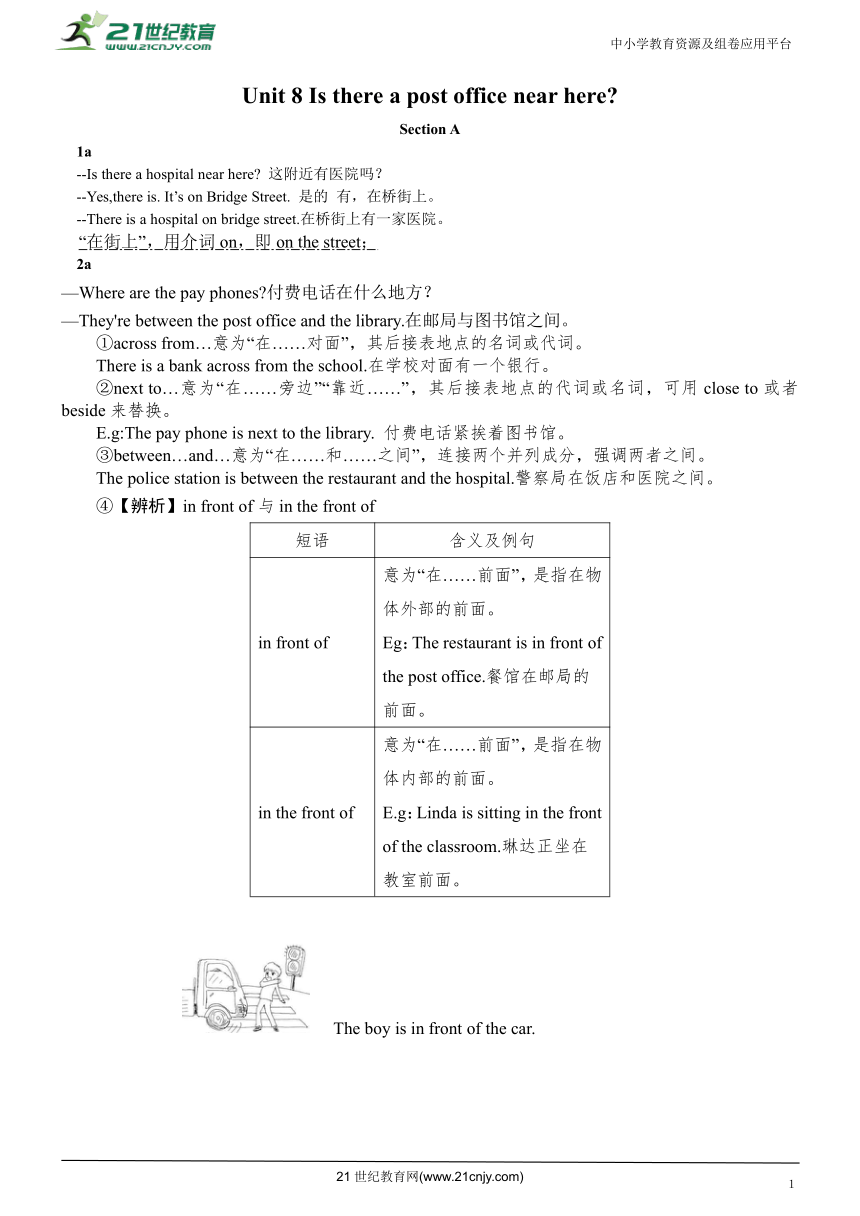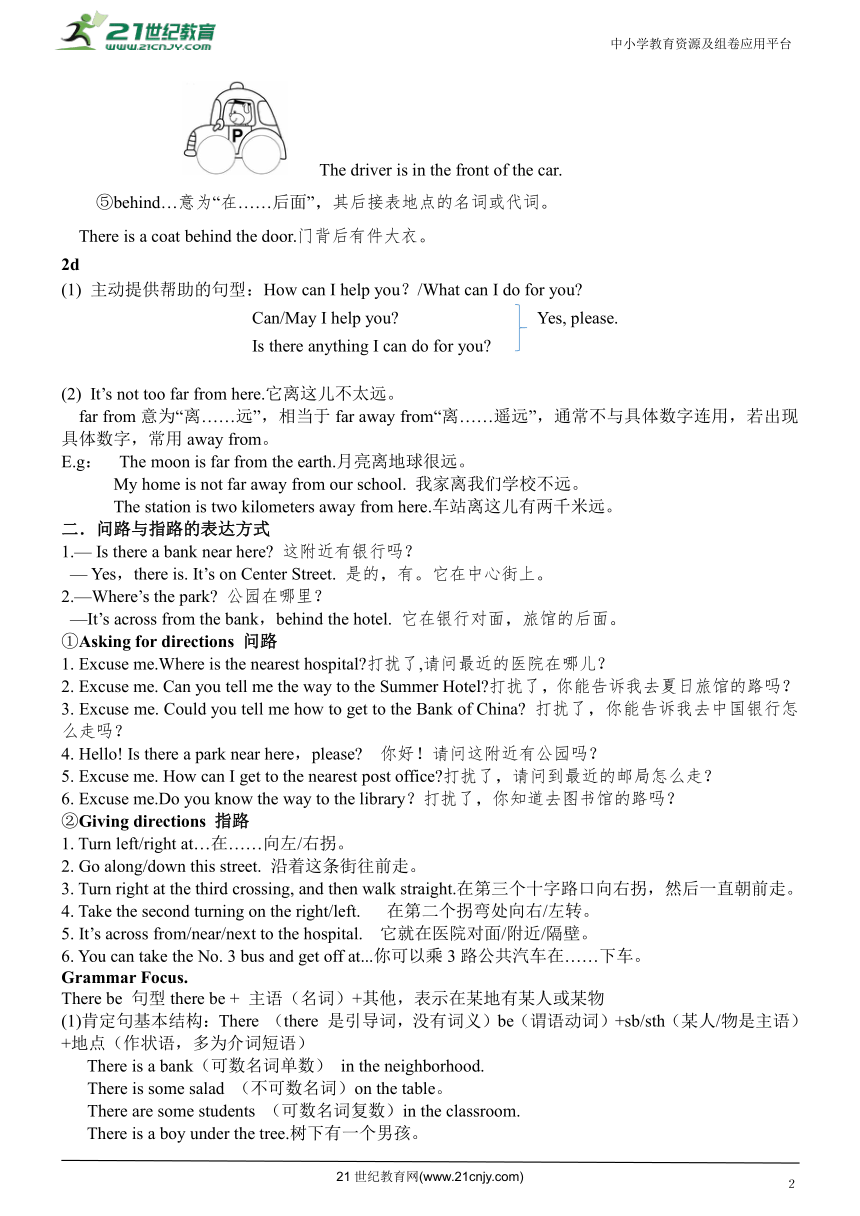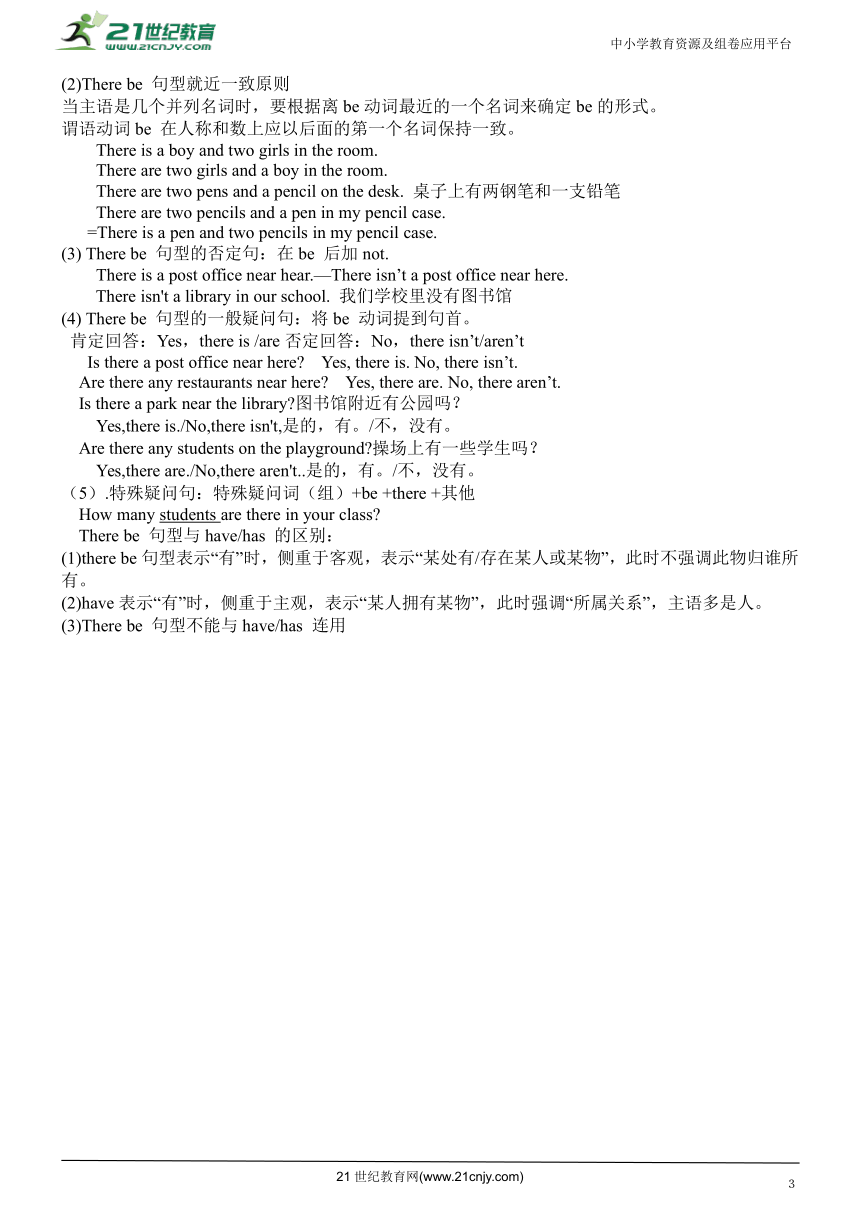Unit 8 Is there a post office near here?知识点总结归纳学案【人教版七年级下册英语】
文档属性
| 名称 | Unit 8 Is there a post office near here?知识点总结归纳学案【人教版七年级下册英语】 |  | |
| 格式 | docx | ||
| 文件大小 | 152.1KB | ||
| 资源类型 | 试卷 | ||
| 版本资源 | 人教新目标(Go for it)版 | ||
| 科目 | 英语 | ||
| 更新时间 | 2024-04-08 21:12:49 | ||
图片预览



文档简介
中小学教育资源及组卷应用平台
Unit 8 Is there a post office near here
Section A
1a
--Is there a hospital near here 这附近有医院吗?
--Yes,there is. It’s on Bridge Street. 是的 有,在桥街上。
--There is a hospital on bridge street.在桥街上有一家医院。
“在街上”,用介词on,即on the street;
2a
—Where are the pay phones 付费电话在什么地方?
—They're between the post office and the library.在邮局与图书馆之间。
①across from…意为“在……对面”,其后接表地点的名词或代词。
There is a bank across from the school.在学校对面有一个银行。
②next to…意为“在……旁边”“靠近……”,其后接表地点的代词或名词,可用close to或者beside来替换。
E.g:The pay phone is next to the library. 付费电话紧挨着图书馆。
③between…and…意为“在……和……之间”,连接两个并列成分,强调两者之间。
The police station is between the restaurant and the hospital.警察局在饭店和医院之间。
④【辨析】in front of与in the front of
短语 含义及例句
in front of 意为“在……前面”,是指在物体外部的前面。 Eg:The restaurant is in front of the post office.餐馆在邮局的前面。
in the front of 意为“在……前面”,是指在物体内部的前面。 E.g:Linda is sitting in the front of the classroom.琳达正坐在教室前面。
The boy is in front of the car.
The driver is in the front of the car.
⑤behind…意为“在……后面”,其后接表地点的名词或代词。
There is a coat behind the door.门背后有件大衣。
2d
主动提供帮助的句型:How can I help you?/What can I do for you
Can/May I help you Yes, please.
Is there anything I can do for you
It’s not too far from here.它离这儿不太远。
far from意为“离……远”,相当于far away from“离……遥远”,通常不与具体数字连用,若出现具体数字,常用away from。
E.g: The moon is far from the earth.月亮离地球很远。
My home is not far away from our school. 我家离我们学校不远。
The station is two kilometers away from here.车站离这儿有两千米远。
二.问路与指路的表达方式
1.— Is there a bank near here 这附近有银行吗?
— Yes,there is. It’s on Center Street. 是的,有。它在中心街上。
2.—Where’s the park 公园在哪里?
—It’s across from the bank,behind the hotel. 它在银行对面,旅馆的后面。
①Asking for directions 问路
1. Excuse me.Where is the nearest hospital 打扰了,请问最近的医院在哪儿?
2. Excuse me. Can you tell me the way to the Summer Hotel 打扰了,你能告诉我去夏日旅馆的路吗?
3. Excuse me. Could you tell me how to get to the Bank of China 打扰了,你能告诉我去中国银行怎么走吗?
4. Hello! Is there a park near here,please 你好!请问这附近有公园吗?
5. Excuse me. How can I get to the nearest post office 打扰了,请问到最近的邮局怎么走?
6. Excuse me.Do you know the way to the library?打扰了,你知道去图书馆的路吗?
②Giving directions 指路
1. Turn left/right at…在……向左/右拐。
2. Go along/down this street. 沿着这条街往前走。
3. Turn right at the third crossing, and then walk straight.在第三个十字路口向右拐,然后一直朝前走。
4. Take the second turning on the right/left. 在第二个拐弯处向右/左转。
5. It’s across from/near/next to the hospital. 它就在医院对面/附近/隔壁。
6. You can take the No. 3 bus and get off at...你可以乘3路公共汽车在……下车。
Grammar Focus.
There be 句型there be + 主语(名词)+其他,表示在某地有某人或某物
(1)肯定句基本结构:There (there 是引导词,没有词义)be(谓语动词)+sb/sth(某人/物是主语)+地点(作状语,多为介词短语)
There is a bank(可数名词单数) in the neighborhood.
There is some salad (不可数名词)on the table。
There are some students (可数名词复数)in the classroom.
There is a boy under the tree.树下有一个男孩。
(2)There be 句型就近一致原则
当主语是几个并列名词时,要根据离be动词最近的一个名词来确定be的形式。
谓语动词be 在人称和数上应以后面的第一个名词保持一致。
There is a boy and two girls in the room.
There are two girls and a boy in the room.
There are two pens and a pencil on the desk. 桌子上有两钢笔和一支铅笔
There are two pencils and a pen in my pencil case.
=There is a pen and two pencils in my pencil case.
(3) There be 句型的否定句:在be 后加not.
There is a post office near hear.—There isn’t a post office near here.
There isn't a library in our school. 我们学校里没有图书馆
(4) There be 句型的一般疑问句:将be 动词提到句首。
肯定回答:Yes,there is /are否定回答:No,there isn’t/aren’t
Is there a post office near here Yes, there is. No, there isn’t.
Are there any restaurants near here Yes, there are. No, there aren’t.
Is there a park near the library 图书馆附近有公园吗?
Yes,there is./No,there isn't,是的,有。/不,没有。
Are there any students on the playground 操场上有一些学生吗?
Yes,there are./No,there aren't..是的,有。/不,没有。
(5).特殊疑问句:特殊疑问词(组)+be +there +其他
How many students are there in your class
There be 句型与have/has 的区别:
(1)there be句型表示“有”时,侧重于客观,表示“某处有/存在某人或某物”,此时不强调此物归谁所有。
(2)have表示“有”时,侧重于主观,表示“某人拥有某物”,此时强调“所属关系”,主语多是人。
(3)There be 句型不能与have/has 连用
Section B
1. (1) on one’s left在某人的左边 on one’s right在某人的右边
There is a toy shop on your left. 在你的左边有一个玩具店。
on the left 在左边 on the right 在右边
(3) on the left of 在......的左边 on the right of 在......的右边
There is a zoo on the right of the library. 在动物园的右边有一个图书馆。
2.along 介词, 沿着, 顺着,靠着......边。 相当于down
we can walk along that road,
Go along this road and we’ll get to his village.
3.Turn right at the first crossing and the restaurant is on your left,across from the pay phone.在第一个十字路口向右转,餐厅在你的左边,付费电话的对面。
(1) crossing 名词 十字路口
(2) turn left/ right at the +序数词+crossing 在第几个十字路口左转/右转。
Turn left at the second crossing= at the second crossing turn left。
在第二个十字路口左转
take the+序数词+crossing on the left/ right 在第几个十字路口左转/右转。
Take the second crossing on the left 在第二个十字路口左转
2b
I like to spend time there on weekends.我喜欢在那儿度过周末时光。
spend,take,cost与pay:四者都有“花费”之意,但用法不同。
spend的主语必须是人,常用于以下结构:
Sb spend time/money on sth. 在……上花费时间/金钱。
I usually spend one hour on my homework.我通常花费一个小时做作业
I spend ten yuan on the book.我花10元买这本书
Sb spend time/money(in)doing sth.花费时间/金钱做某事。
I usually spend one hour (in) doing my homework.我通常花费一小时做作业
They spend two years (in) building this bridge.建造这座桥花了他们两年时间。
cost的主语是物或某种活动,还可以表示“值”,常见用法如下:
sth. cost(s) (sb.)+金钱,意思是“某物花了(某人)多少钱”。
A new computer costs a lot of money.买一台新电脑要花一大笔钱。
(doing)sth.costs (sb.)+时间,意思是“某物(做某事)花了(某人)多少时间”。
Remembering these new words cost him a lot of time.
他花了大量时间才记住了这些单词。
take 主要指花费时间,it作形式主语:
It takes sb.+时间+to do sth.做某事花了某人多少时间。
It takes him 20 minutes to get to school.每天他花费20分钟到达学校。
pay的主语是人,基本用法如下:
(sb.)pay some money for sth.某人为某物付款。
I have to pay them 20 pounds for this room each month.
我每个月要付20英镑的房租。
pay for sth.付……的钱。I have to pay for the book lost.我不得不赔丢失的书款
spend 主语是人 Sb.spend(s)…on sth. Sb.spend(s)…(in) doing sth. 某人花时间/金钱做某事
take 常用it作 形式主语 It takes sb.some time to do sth. 某人花费多长时间做某事
cost 主语是物 Sth.cost(s) sb.some money. 某物花费某人多少钱
pay 主语是人 Sb. pay(s) some money for sth. 某人为某物付款
I love to watch the monkeys climbing around.我喜欢看猴子们到处爬来爬去。
Watch sb.doing sth. 观看某人正在做某事 强调所做的事正在进行中
watch sb. do sth. 观看某人做过或经常做某事 所做的事为经常发生或已做过的事情
I watched the girl helping others.我看见这个女孩正在帮助别人。
I often watch Lily play the piano.我经常看莉莉弹钢琴。
I often hear some girls singing in the classroom. 我经常听见一些女孩在教室里唱歌
To get to the park, you just have to cross Center Street.
为了到达公园,你只需要穿过中心街。
to get to the park 是目的状语前置,放在句首起强调作用。也可放在句末。
e.g. To get a good grade, we must study hard.
To learn English well,he needs a dictionary.
He works day and night to get the money.
4. It is very quite and I enjoy reading there. 这里很安静,我喜欢在这里阅读。
(1))enjoy v.享受;喜爱 enjoyable adj. 高兴的
1)enjoy sth 喜欢某物
2)enjoy doing sth 喜欢做某事He enjoys listening to music. 他喜欢听音乐
3)enjoy oneself=have fun =have a good time 玩得高兴
5 . You can get to the library easily. 你可以很容易的到达图书馆。
easy 容易的 修饰名词 easily 容易地;轻松地 修饰动词
The question is so easy. 这个问题如此简单。
You can get to the library easily. 你很容易就能到达图书馆。
6. It’s one’s turn to do sth 轮到某人做某事
It is our turn to clean the classroom.
Take turns to do sth. 轮流去做某事
Take turns to clean the blackboard.
3b(作文)
假如你是李平,以下是你的美国笔友Bob 给你发的邮件。请阅读后进行回复。
Dear Li Ping, You said you moved to a new neighborhood. How is it Can you tell me something about it And what's your favorite place in your neighborhood Why How do you get there from your home Yours, Bob
注意:1)内容必须包含来信和图中的信息。
,
Dear Li Ping,
I live in a busy neighborhood. There is a supermarket behind my house. There's a restaurant and a post office on Bridge Street. But I like the library best. It's quiet and clean. I enjoy reading books there. When I read books, time goes quickly. To get there, I just walk along Bridge Street. The library is across from my house.
Yours,
Li Ping
21世纪教育网(www.21cnjy.com)
Unit 8 Is there a post office near here
Section A
1a
--Is there a hospital near here 这附近有医院吗?
--Yes,there is. It’s on Bridge Street. 是的 有,在桥街上。
--There is a hospital on bridge street.在桥街上有一家医院。
“在街上”,用介词on,即on the street;
2a
—Where are the pay phones 付费电话在什么地方?
—They're between the post office and the library.在邮局与图书馆之间。
①across from…意为“在……对面”,其后接表地点的名词或代词。
There is a bank across from the school.在学校对面有一个银行。
②next to…意为“在……旁边”“靠近……”,其后接表地点的代词或名词,可用close to或者beside来替换。
E.g:The pay phone is next to the library. 付费电话紧挨着图书馆。
③between…and…意为“在……和……之间”,连接两个并列成分,强调两者之间。
The police station is between the restaurant and the hospital.警察局在饭店和医院之间。
④【辨析】in front of与in the front of
短语 含义及例句
in front of 意为“在……前面”,是指在物体外部的前面。 Eg:The restaurant is in front of the post office.餐馆在邮局的前面。
in the front of 意为“在……前面”,是指在物体内部的前面。 E.g:Linda is sitting in the front of the classroom.琳达正坐在教室前面。
The boy is in front of the car.
The driver is in the front of the car.
⑤behind…意为“在……后面”,其后接表地点的名词或代词。
There is a coat behind the door.门背后有件大衣。
2d
主动提供帮助的句型:How can I help you?/What can I do for you
Can/May I help you Yes, please.
Is there anything I can do for you
It’s not too far from here.它离这儿不太远。
far from意为“离……远”,相当于far away from“离……遥远”,通常不与具体数字连用,若出现具体数字,常用away from。
E.g: The moon is far from the earth.月亮离地球很远。
My home is not far away from our school. 我家离我们学校不远。
The station is two kilometers away from here.车站离这儿有两千米远。
二.问路与指路的表达方式
1.— Is there a bank near here 这附近有银行吗?
— Yes,there is. It’s on Center Street. 是的,有。它在中心街上。
2.—Where’s the park 公园在哪里?
—It’s across from the bank,behind the hotel. 它在银行对面,旅馆的后面。
①Asking for directions 问路
1. Excuse me.Where is the nearest hospital 打扰了,请问最近的医院在哪儿?
2. Excuse me. Can you tell me the way to the Summer Hotel 打扰了,你能告诉我去夏日旅馆的路吗?
3. Excuse me. Could you tell me how to get to the Bank of China 打扰了,你能告诉我去中国银行怎么走吗?
4. Hello! Is there a park near here,please 你好!请问这附近有公园吗?
5. Excuse me. How can I get to the nearest post office 打扰了,请问到最近的邮局怎么走?
6. Excuse me.Do you know the way to the library?打扰了,你知道去图书馆的路吗?
②Giving directions 指路
1. Turn left/right at…在……向左/右拐。
2. Go along/down this street. 沿着这条街往前走。
3. Turn right at the third crossing, and then walk straight.在第三个十字路口向右拐,然后一直朝前走。
4. Take the second turning on the right/left. 在第二个拐弯处向右/左转。
5. It’s across from/near/next to the hospital. 它就在医院对面/附近/隔壁。
6. You can take the No. 3 bus and get off at...你可以乘3路公共汽车在……下车。
Grammar Focus.
There be 句型there be + 主语(名词)+其他,表示在某地有某人或某物
(1)肯定句基本结构:There (there 是引导词,没有词义)be(谓语动词)+sb/sth(某人/物是主语)+地点(作状语,多为介词短语)
There is a bank(可数名词单数) in the neighborhood.
There is some salad (不可数名词)on the table。
There are some students (可数名词复数)in the classroom.
There is a boy under the tree.树下有一个男孩。
(2)There be 句型就近一致原则
当主语是几个并列名词时,要根据离be动词最近的一个名词来确定be的形式。
谓语动词be 在人称和数上应以后面的第一个名词保持一致。
There is a boy and two girls in the room.
There are two girls and a boy in the room.
There are two pens and a pencil on the desk. 桌子上有两钢笔和一支铅笔
There are two pencils and a pen in my pencil case.
=There is a pen and two pencils in my pencil case.
(3) There be 句型的否定句:在be 后加not.
There is a post office near hear.—There isn’t a post office near here.
There isn't a library in our school. 我们学校里没有图书馆
(4) There be 句型的一般疑问句:将be 动词提到句首。
肯定回答:Yes,there is /are否定回答:No,there isn’t/aren’t
Is there a post office near here Yes, there is. No, there isn’t.
Are there any restaurants near here Yes, there are. No, there aren’t.
Is there a park near the library 图书馆附近有公园吗?
Yes,there is./No,there isn't,是的,有。/不,没有。
Are there any students on the playground 操场上有一些学生吗?
Yes,there are./No,there aren't..是的,有。/不,没有。
(5).特殊疑问句:特殊疑问词(组)+be +there +其他
How many students are there in your class
There be 句型与have/has 的区别:
(1)there be句型表示“有”时,侧重于客观,表示“某处有/存在某人或某物”,此时不强调此物归谁所有。
(2)have表示“有”时,侧重于主观,表示“某人拥有某物”,此时强调“所属关系”,主语多是人。
(3)There be 句型不能与have/has 连用
Section B
1. (1) on one’s left在某人的左边 on one’s right在某人的右边
There is a toy shop on your left. 在你的左边有一个玩具店。
on the left 在左边 on the right 在右边
(3) on the left of 在......的左边 on the right of 在......的右边
There is a zoo on the right of the library. 在动物园的右边有一个图书馆。
2.along 介词, 沿着, 顺着,靠着......边。 相当于down
we can walk along that road,
Go along this road and we’ll get to his village.
3.Turn right at the first crossing and the restaurant is on your left,across from the pay phone.在第一个十字路口向右转,餐厅在你的左边,付费电话的对面。
(1) crossing 名词 十字路口
(2) turn left/ right at the +序数词+crossing 在第几个十字路口左转/右转。
Turn left at the second crossing= at the second crossing turn left。
在第二个十字路口左转
take the+序数词+crossing on the left/ right 在第几个十字路口左转/右转。
Take the second crossing on the left 在第二个十字路口左转
2b
I like to spend time there on weekends.我喜欢在那儿度过周末时光。
spend,take,cost与pay:四者都有“花费”之意,但用法不同。
spend的主语必须是人,常用于以下结构:
Sb spend time/money on sth. 在……上花费时间/金钱。
I usually spend one hour on my homework.我通常花费一个小时做作业
I spend ten yuan on the book.我花10元买这本书
Sb spend time/money(in)doing sth.花费时间/金钱做某事。
I usually spend one hour (in) doing my homework.我通常花费一小时做作业
They spend two years (in) building this bridge.建造这座桥花了他们两年时间。
cost的主语是物或某种活动,还可以表示“值”,常见用法如下:
sth. cost(s) (sb.)+金钱,意思是“某物花了(某人)多少钱”。
A new computer costs a lot of money.买一台新电脑要花一大笔钱。
(doing)sth.costs (sb.)+时间,意思是“某物(做某事)花了(某人)多少时间”。
Remembering these new words cost him a lot of time.
他花了大量时间才记住了这些单词。
take 主要指花费时间,it作形式主语:
It takes sb.+时间+to do sth.做某事花了某人多少时间。
It takes him 20 minutes to get to school.每天他花费20分钟到达学校。
pay的主语是人,基本用法如下:
(sb.)pay some money for sth.某人为某物付款。
I have to pay them 20 pounds for this room each month.
我每个月要付20英镑的房租。
pay for sth.付……的钱。I have to pay for the book lost.我不得不赔丢失的书款
spend 主语是人 Sb.spend(s)…on sth. Sb.spend(s)…(in) doing sth. 某人花时间/金钱做某事
take 常用it作 形式主语 It takes sb.some time to do sth. 某人花费多长时间做某事
cost 主语是物 Sth.cost(s) sb.some money. 某物花费某人多少钱
pay 主语是人 Sb. pay(s) some money for sth. 某人为某物付款
I love to watch the monkeys climbing around.我喜欢看猴子们到处爬来爬去。
Watch sb.doing sth. 观看某人正在做某事 强调所做的事正在进行中
watch sb. do sth. 观看某人做过或经常做某事 所做的事为经常发生或已做过的事情
I watched the girl helping others.我看见这个女孩正在帮助别人。
I often watch Lily play the piano.我经常看莉莉弹钢琴。
I often hear some girls singing in the classroom. 我经常听见一些女孩在教室里唱歌
To get to the park, you just have to cross Center Street.
为了到达公园,你只需要穿过中心街。
to get to the park 是目的状语前置,放在句首起强调作用。也可放在句末。
e.g. To get a good grade, we must study hard.
To learn English well,he needs a dictionary.
He works day and night to get the money.
4. It is very quite and I enjoy reading there. 这里很安静,我喜欢在这里阅读。
(1))enjoy v.享受;喜爱 enjoyable adj. 高兴的
1)enjoy sth 喜欢某物
2)enjoy doing sth 喜欢做某事He enjoys listening to music. 他喜欢听音乐
3)enjoy oneself=have fun =have a good time 玩得高兴
5 . You can get to the library easily. 你可以很容易的到达图书馆。
easy 容易的 修饰名词 easily 容易地;轻松地 修饰动词
The question is so easy. 这个问题如此简单。
You can get to the library easily. 你很容易就能到达图书馆。
6. It’s one’s turn to do sth 轮到某人做某事
It is our turn to clean the classroom.
Take turns to do sth. 轮流去做某事
Take turns to clean the blackboard.
3b(作文)
假如你是李平,以下是你的美国笔友Bob 给你发的邮件。请阅读后进行回复。
Dear Li Ping, You said you moved to a new neighborhood. How is it Can you tell me something about it And what's your favorite place in your neighborhood Why How do you get there from your home Yours, Bob
注意:1)内容必须包含来信和图中的信息。
,
Dear Li Ping,
I live in a busy neighborhood. There is a supermarket behind my house. There's a restaurant and a post office on Bridge Street. But I like the library best. It's quiet and clean. I enjoy reading books there. When I read books, time goes quickly. To get there, I just walk along Bridge Street. The library is across from my house.
Yours,
Li Ping
21世纪教育网(www.21cnjy.com)
同课章节目录
- Unit 1 Can you play the guitar?
- Section A
- Section B
- Unit 2 What time do you go to school?
- Section A
- Section B
- Unit 3 How do you get to school?
- Section A
- Section B
- Unit 4 Don't eat in class.
- Section A
- Section B
- Unit 5 Why do you like pandas?
- Section A
- Section B
- Unit 6 I'm watching TV.
- Section A
- Section B
- Review of Units 1-6
- Unit 7 It's raining!
- Section A
- Section B
- Unit 8 Is there a post office near here?
- Section A
- Section B
- Unit 9 What does he look like?
- Section A
- Section B
- Unit 10 I'd like some noodles.
- Section A
- Section B
- Unit 11 How was your school trip?
- Section A
- Section B
- Unit 12 What did you do last weekend?
- Section A
- Section B
